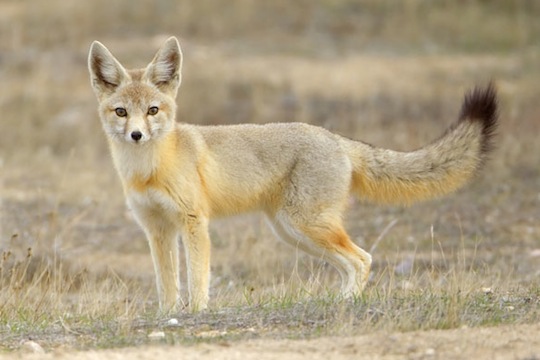San Joaquin Kit Fox
By Kali Leonard
Much of the historic and current range of the San Joaquin Kit Fox is still unknown; mostly because much of the land in the San Joaquin Valley is private property and is unable to be observed. Historically the fox inhabited most of the valley but today the fox only inhabits fragments of the valley and parts of the central coast. A study by Grinnell in 1937 estimated that the the kit fox range in the San Joaquin Valley was reduced by half by the 1930s. The valley does have refuges for the fox at Bitter Creek National Refuge, Grasslands Wildlife Management Area, Kern National Wildlife Refuge, Merced National Wildlife Refuge, and Pixley National Wildlife Refuge.
The San Joaquin Kit Fox was first listed as endangered on March 11, 1967 and has been endangered for over 50 years this month. A recovery plan was approved in 1983. The plan stated that recovering the kit fox population would be "considered critical to recovery of many other species in the San Joaquin Valley."
By Kali Leonard
 |
| Picture |
Description and Ecology
The San Joaquin Kit Fox is one of the smallest of the canid species in North America. They weigh about 5 lbs and average 30 inches long with a bushy tail of 11 inches. Their coat is tan in the summer and a silver grey color in the winter. They have a distinct black tipped tail and long ears. Their diet consists of one third rodents and also eat some vegetation and insects. They are nocturnal and use dens as shelter. Females usually have a 2-6 pups litter in early spring.
Geographic and Population Changes
 |
| Picture: http://esrp.csustan.edu/gis/maps/sjkfrange.png |
Much of the historic and current range of the San Joaquin Kit Fox is still unknown; mostly because much of the land in the San Joaquin Valley is private property and is unable to be observed. Historically the fox inhabited most of the valley but today the fox only inhabits fragments of the valley and parts of the central coast. A study by Grinnell in 1937 estimated that the the kit fox range in the San Joaquin Valley was reduced by half by the 1930s. The valley does have refuges for the fox at Bitter Creek National Refuge, Grasslands Wildlife Management Area, Kern National Wildlife Refuge, Merced National Wildlife Refuge, and Pixley National Wildlife Refuge.
The San Joaquin Kit Fox was first listed as endangered on March 11, 1967 and has been endangered for over 50 years this month. A recovery plan was approved in 1983. The plan stated that recovering the kit fox population would be "considered critical to recovery of many other species in the San Joaquin Valley."
Main Threats
The San Joaquin Valley has undergone huge transformation since the arrival of settlers. The valley used to be a huge network of wetlands. Today, however, the valley has been converted into mostly farm land. The decline of the San Joaquin Kit Fox has ultimately been because of this land transformation. The US Fish and Wildlife recovery plan stated major population decline was due to "Loss, degradation, and fragmentation of habitats associated with agricultural, industrial, and urban developments in the San Joaquin Valley" (picture from Professor Frazier's lecture).


No comments:
Post a Comment